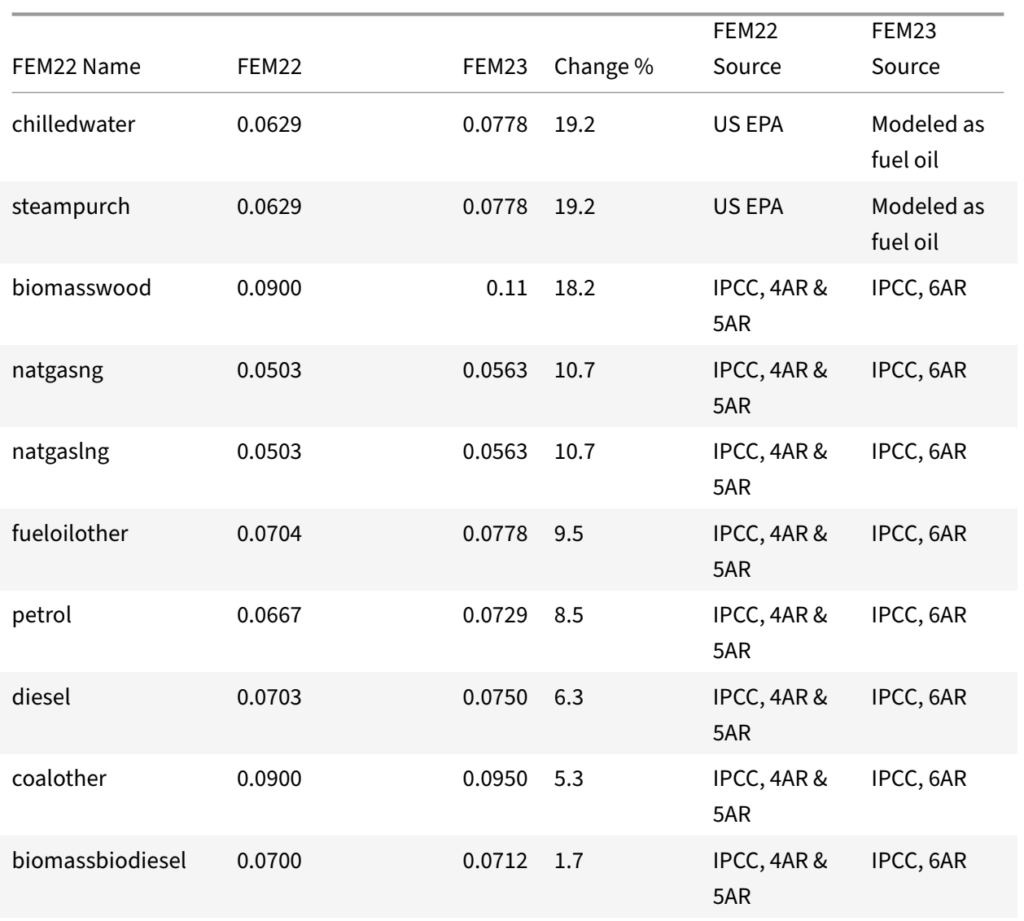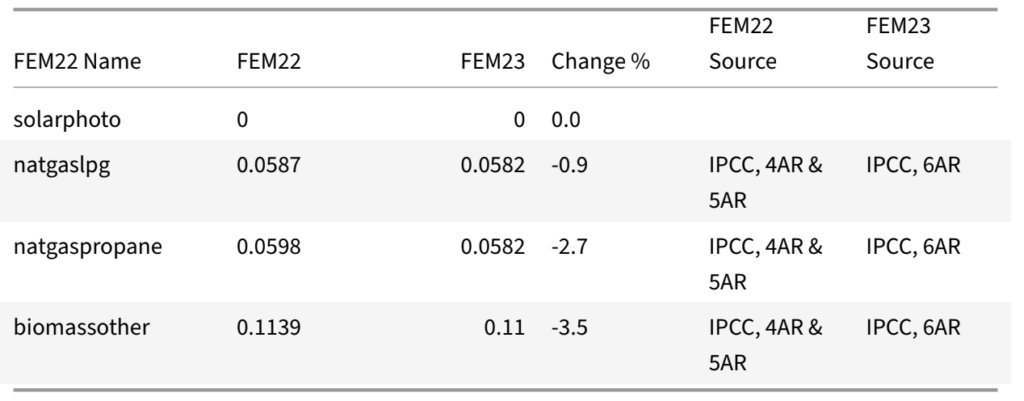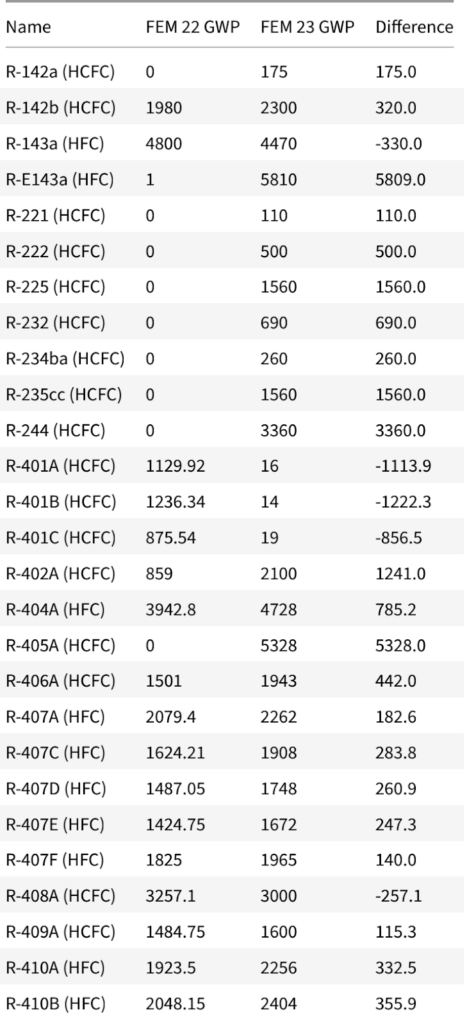Table of Contents
2. Stationary Source Energy Densities
3. Stationary Source Emission Factors
4. Changed Refrigerant Emission Factors
To download this guide in PDF format, please see the FEM4.0 resources page.
The transition from FEM 3.0 to FEM 4.0 for the FEM 2023 cadence will cause changes to kg CO2e and energy use totals calculated in FEM reporting that are not caused by changes in facility energy usage or emissions intensity.
For reporting use cases that rely on tracking energy and kg CO2e totals from FEM it is important to understand the causes of the changes so that the right adjustments, if any, can be made for the use case.
The document lays out potential sources of change at a level granular enough to allow FEM data con‑ sumers to understand and account for changes in the transition from FEM 3.0 to FEM 4.0 data.
Expected Size of Changes
This analysis ignores:
- New energy sources and possibilities for facilities to report more granular/specific emission factors for others ‑ both of which would be difficult to account for
- Changes to refrigerant emissions which are discussed later
The average facility will see an increase in total kg CO2e emissions of slightly more than 2.5% because of changes between FEM 3.0 and FEM 4.0. The median facility sees an increase of slightly less than 1.5%.
The 10th percentile of facilities will see no change and the 90th percentile will see a 10% increase. The largest increase is about 30% and the largest decrease is about 24%.
Facilities using chilled water or purchased steam drive a large portion of the expected change. Without adjustment to those energy sources, the median change drops to less than 1%. Because facilities will set their energy density and emission factor for both sources the actual impact of modeling the emission factor as fuel oil is unpredictable but likely to be much lower than stated in this analysis.
In practice, facilities using large amounts of wood biomass will see the largest decreases and facilities using large amounts of generic biomass and natural gas will see the largest increases. The biomass shifts because of the roll up of the two sources into a single source in FEM 4.0 and natural gas because of an increase in the emission factor.
Stationary Source Energy Densities
For mass units the energy density is expressed in MJ/kg, and for volume units as MJ/l. Values in have been truncated to 4 decimal places and 1 for the Change % column.
Notes
steampurch both has an energy density calculated from user input in FEM 2023 if reported in mass or volume units using the pressure and temperature of the steam.
biomassother and biomasswood have been replaced by a generic biomass energy source and the energy density is set in the middle of expected biomass sources.
Stationary Source Emission Factors
All emission factors in the following tables are expressed as kgCO2e/MJ FEM22


Notes
Emission factors for purchrenew, chilledwater, and steampurch may be set by the facility in FEM 2023 either by directly setting the value or specifying the mix of energy sources used to create the secondary energy source.
Changed Refrigerant Emission Factors
The median facility with reported refrigerant usage (about 15% in a cadence) will see a more than 13% increase in the reported refrigerant kg CO2e because of increased global warming potential (GWP). The overwhelming bulk of the change is from refrigerants that were modeled as zero emissions in previous cadences because of a lack of data which now have reliable GWPs. The refrigerants modeled as zero emissions in FEM 2022 represented a small proportion of overall refrigerant use in FEM and most were completely unused leading to the increase in reported refrigerant kg CO2e being smaller than might otherwise be expected. Because many comparisons start from zero the change is expressed in absolute terms rather than as a percentage.


Notes
Due to the large number of refrigerants the table of refrigerant emission factor changes is limited to refrigerants historically used in FEM that have changed by a significant amount.
Grid Emission Factors
In both FEM 3.0 and FEM 4.0 grid emission factors are licensed and cannot be shared.
FEM 2023 uses the same grid emission factors as FEM 2022 so purchased electricity will not be a source of variation in GHG calculations. # New and Modified Energy Sources
For specific details on energy sources used in FEM 2023 please see the FEM 2023 Energy and Carbon documentation.
New
- Biogas
- Reference: biogas
- Impact: extremely similar properties to natgasng which it would have been reported as previously. Likely to have a minimal effect.
- Biomass
- Reference: biomasscert and biomassgen
- Impact: Middle ground between the previously available biomasswood and biomas sother which it would previously have been one of. The effective emissions of wood in‑ crease but the energy density increases partially offsetting so the impact should be small.
- Coal Water Slurry
- Reference: coalwaterslurry
- Impact: Emission factor modeled as the same as coal absent clear authoritative source.If reported previously would have been as coal converted to mass units so the impact should be small. Scope of use is unclear.
- District Heating
- Reference: districtheating
- Impact: Energy density must be self reported by facility as delta between intake and out‑ put temperatures. Emission factor may be specified by facility. Default emission factor modeled assuming heat generation using fuel oil. If previously reported would have been as the primary energy source and so should have a minimal impact.
- Ethanol
- Reference: ethenol
- Impact: Vehicle only, would previously have been reported as petrol or unreported. May have a small impact because of decreased energy density of ethanol relative to petrol.
- Hydrogen
- Reference: hydrogennr and hydrogenr
- Impact: Vehicle only, would previously have been unreported. Minimal impact is expected.
Modified
- Chilled Water
- Reference: chilledwater
- Impact: Emission factor may be specified by the facility. Default emission factor changed from US EPA source based on the US grid to assumption of fuel oil. Unpredictable impact depending on scale of reporting of specific emission factors.
- Purchased Steam
- Reference: steampurch
- Impact: Emission factor may be specified by the facility. Default emission factor changed from US EPA source based on the US grid to assumption of fuel oil. Unpredictable impact depending on scale of reporting of specific emission factors.
- Purchased Renewable
- Reference: purchrenew
- Impact: Emission factor may be specified by the facility. Typical emission factor likely to remain near default of 0 for minimal impact.
